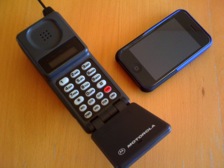Last year, I experienced two months that were very challenging for me as a person and as an academic. One of my sons, who was seven, became very ill and missed a lot of school. When he returned, he was in a wheelchair, and he was very unsure of himself. He didn’t know if he had enough stamina to make it through the day, and he worried that his teachers and his fellow students would be upset with him. No matter how much I tried to convince him that it would be OK, he was too nervous to return, alone, to his classroom.
So, I told him I would shadow him in class for a few days to help make the transition smoother.
It’s been a long time since I was in the second grade, and as I sat through his day, I was very impressed with the level of preparation and organization the teachers exhibited. Some things were the same: the teachers were engaging and exciting, there was a lot of activity, and the kids were overwhelmingly nice, but there were also a few things that were completely new — like the use of technology.
The Promethean board was the most obvious piece of technology in the room, followed closely by a few Apple computers and an iPad. However, when it came to using this technology, I was somewhat concerned by what I saw.
It wasn’t that the teachers weren’t good. They were amazing, actually, but I was concerned that I didn’t see them using most of the technology they had at their fingertips to make what they had even better and more engaging.
For example, they used the Promethean board to bring up the schedule of the day, but not as a teaching/learning resource. I expected to see them bring up things the kids could interact with, show a video, or even bring up some visual resources like maps and pictures — but I didn’t see the teachers using this powerful technology to its full advantage. Most of the instruction was exactly as I remembered it from my years in school — lots of scissors, glue, paper, and worksheets. Worksheets? Yes, worksheets.
Where was all this “project based” and “flipped classroom” stuff I had heard so much about? What was going on?
What I found out is that these wonderful educators didn’t have time to integrate the technology they had available into their classroom routine. They had been doing things pretty much the same way they had been doing them forever, and they had no idea that some tools were available that would make the time they spent on grading, parent communication, and classroom management much easier and more time efficient.
I tried to talk to them about some of the stuff they could use, but I realized that what I said was overwhelming and strange to them. They simply didn’t have time to learn or explore the resources I suggested, and they weren’t really sure they wanted to. After all, what they were doing was working. Why change?
And that became the beginning of my own self-questioning. Why change? What did these teachers have to gain by embracing technology in their classroom? Why should they spend hours familiarizing themselves with a tool when what they were doing was perfectly fine?
The answer is that the status quo is just fine for them, but I wasn’t sure if their use of classroom technology was sending the right message to their students. In my own classroom I see the outcome of “just fine” educational systems. The students are well educated, it’s true, but they have a strange belief that learning is connected to books and teachers, and leisure is connected to technology.
So, when a “digital native” walks into my classroom, they have all kinds of ideas about how to entertain themselves and socialize with technology, but they have no inkling of how to use technology to improve learning. If our nation is going to survive this new digital world, we have to encourage our students to see technology as a learning tool, and encourage our students to seek out tools to improve and enhance their learning. As Jesse Stommel argues in his video Hybrid Academic Collectives, we must look beyond tradition to embrace what is possible.
As a teacher, I realize that every lesson should be built to reach students’ multiple intelligences in multiple ways — teaching to every learning style as deeply and completely as I can — then recursively adding to my lessons semester after semester to integrate more tools, filling in the learning voids whenever possible. For example, teachers can start by using Promethean and SMART boards to enrich a short reading assignment by displaying a picture of the author, a map of where the author is from, and some information about the background of the reading; the following year they may ask students to participate in the discovery process by looking for information to display and contributing it. The teacher might begin to look at the Promethean board as a window into the larger culture of learners by inviting the author or a children’s literature specialist to speak to the students via Skype or a G+ Hangout; or, in subsequent years, with more preparation, connecting to another class that is studying the same work for a long-distance discussion. Each level of technology use builds upon the next, growing in complexity.
In addition, we need to start thinking of ways to structure assignments so that our students don’t just learn about one or two types of technology, but that they actually begin exploring and evolving in their idea of technology use for their own needs. As Alan Rudi argues in Hybrid Learning: How to Reach Digital Natives, “today’s students do best when you give them a sense of purpose and control over what they’re learning.” Students are very good at finding technology, and the technology they use to entertain or socialize can easily be turned into technology that is used to create, investigate, and publish scholarly work.
The educators tasked to reach these digital natives where they live may not be as savvy with technology as their students are, but they do know about learning. Although this may lead to the teacher feeling overwhelmed or intimidated by their students’ technological prowess, or frustrated that they can’t turn that digital know-how into a greater opportunity, it is not a time to go into self-defense mode. It is very appealing to just stick our heads in the sand and say, “the students need to focus on basic skills” so that we can go back to our comfort zone. This no longer works because digital know-how has already become a “basic skill.” It’s not 1980. Every business and educational institution, private and public, has already embraced technology, and our students can’t hope to compete in a 21st century economy without those skills.
Unfortunately, the majority of educational institutions have institutionalized the head-in-sand approach. In order to protect their authority, many teachers and administrators turn to limitations on technology rather than embracing these powerful educational tools. According to “Cell Phones in the Classroom: Educator’s Perspective,” 62% of US Schools have a ban on smartphones in the classrooms, and according to Social Media Access in K-12 Schools: Intractable Policy Controversies in an Evolving World, “Currently most schools ban social networking and chat rooms, and over a third ban the sharing of visual media files, playing interactive games, sharing music or sound files and posting message on web sites.” The problem is that most of the Web 2.0 educational offerings involve social networking, chat rooms, visual media files, interactive games, music and sound files and posting on websites.
Cell-phone bans go all the way back to the 1980s when pagers and cell phones were rare and expensive. District after district put in bans on pagers and cell phones in schools to prevent gang activity, as most pagers and cell phones were used for the sale of narcotics. At the time, no one could find a good reason for cell phones to be allowed in school, and many laws were passed in states to prevent cell phone use. In the intervening years, although cell phones became cheaper and more widely used, the bans remained in place — mostly because cell phones were considered “disruptive” in the classroom. Those state bans stayed in effect until shortly after September 11, 2001, when the importance of emergency communication took precedence over a distraction-free school day, and parents wanted easier access to communication with their children.
Although most schools have started to allow the use of smart phones before and after school, and during lunch periods, most still ban their use during the school day. For today’s digital natives those bans don’t make any sense. I have been called into school more than once when my high school son’s phone was confiscated in the halls when he tried to access his Google Calendar to record an upcoming assignment, or he texted his friend to ask when a paper was due. “It’s so natural to use my phone, that I didn’t even think about it,” he said in his own defense. He’s also made the argument to his teachers that there is no difference between using a dictionary in his phone and using a dictionary in book form — except for the obvious convenience of using a phone. (It is an argument he has won more than once, by the way!)
Even when students are allowed to use technology in the very controlled environment of a computer lab, schools have shut down YouTube, Facebook, Twitter, and even Google in an effort to keep students focused on educational content and to avoid violating the Children’s Internet Protection Act (CIPA). According to Audrey Watters in her article, “Cellphones in the Classroom: Distraction or Tool?”:
Schools and libraries that receive E-rate funding from the federal government are required by CIPA to block or filter obscene material. As a result, most schools implement various levels of filtering, some much more stringent than what CIPA mandates.
The E-rate program is a program that provides discounts to schools and libraries to purchase internet services and computers. Discounts that schools can receive from the E-Rate program are 20-90% off the retail price of computers and internet access. Schools are worried that, if they provide wireless internet access to social networks on their Local Area Network (LAN), that they will violate the CIPA. However, the CIPA mandates only that the school make a reasonable effort to block or filter obscene content, it doesn’t mandate that the school block entire social networks or prevent cell phones from using school wireless to access those networks. Nonetheless, many schools are hesitant to allow social network access to their LAN for fear of jeopardizing much needed technology discounts.
I have seen the “digital natives” in my own classroom struggle with the limitations placed upon them by irrational school policies that limit the use of laptops, notebooks, and mobile devices in school settings. It is truly a ballet of the absurd. Teachers and professors are stuck in the middle as students demand more access to the media they use on a daily basis to get their work done, and IT professionals and administrators, fearful at skirting federal law, shut down entire sectors of the internet with filters and jammers. So, while the motivational speakers and internet evangelists preach about the magic of Web 2.0, most of us have found ourselves locked out of much of that rich content by well-meaning laws and overly protective administrative policies.
It isn’t only those policies that are holding us back. We’ve also been stifled by the public nature of contemporary communication. We know, for example, that publication of student work increases the quality of that work. As a graduate student in Teaching Writing in the 1980s, I was exposed to theCalifornia Writing Project, which put a lot of stock in the publication of student work. At the time, publication took the form of a mimeographed booklet, stapled together, and sent home with the student’s weekly work; but it wasn’t the quality of the publication, it was the very existence of publication that was significant. As Peter Elbow opined in his seminal work Everyone Can Write: Essays toward a Hopeful Theory of Writing and Teaching Writing:
The fact of publication — seeing all your classmates holding in their hands a copy of a class magazine that contains your writing — increases the pressure from peer readers. By the same token, it helps put teacher standards into more perspective.
It wasn’t really until the age of blogs that the idea of publication could really catch on — but it hasn’t. Rather than grasping at the chance to provide our students with the opportunity to produce authentic writing, and beautifully illustrated publications instantly available to anyone with an internet connection, I saw my colleagues wringing their hands in worry that students would produce work that would not exhibit the capabilities of the school, or that they would write “inappropriate,” things in their blogs. I was astonished when the head of the college writing program I was working at insisted that every student’s blog be set to “private” because she feared violating the student’s right to privacy or embarrassing the department. I had to ask, “What is the point of blogging to yourself?” (She wasn’t amused.)
In her defense, I know it may take an educator many years to understand the particular political and administrative challenges to technology in the classroom, and by the time they do, they have lost more battles than they have won. The greatest obstacle in public school systems — both K-12 and college and university systems — is an embedded bureaucracy that works toward preserving the status-quo. Often those who have been in the system for years are the first to wave the white flag of surrender and start teaching without technology, or start looking for a way that they can fly under the radar by compromising the very nature of the technology they are teaching. “Why should I fight?” they say. “Everyone says what they are doing is working fine.”
It shouldn’t be this hard, but it is. This isn’t something a teacher or student, a parent or an administrator can do alone. It is something we must work toward together. There needs to be an ongoing dialogue between the contingent groups working toward bringing the internet into our classrooms in a more meaningful and complete way; and those contingent groups must be fully aware that each group has something they want to get and something they want to protect from the process:
- teachers may fear changing the way they teach and giving up authority in their classroom;
- instructional technology professionals may fear endangering the security of their network, introducing viruses into the system, or overwhelming their capability to provide connections;
- administrators may fear skirting federal, state, or local educational laws, and they may be concerned about how providing better technology infrastructure may affect their budget; and
- parents and students may fear the public nature of the internet and the vulnerability of student information.
Every fear must be discussed in an environment of understanding and cooperation, and everyone must be dedicated to finding solutions to getting our students a safe, open, and growing portal to the internet. We shouldn’t have to fight so hard for what makes logical, educational, and pedagogical sense — but we do, and we owe it to our students to fight with everything we have.
For a practical, hands-on guide to using technology in your classroom, see Michelle Kassorla’s follow-up “A Primer for EdTech: Tools for K-12 and Higher Ed. Teachers.”
[Images by Phillip Wilke, Peter Werkman, Jerry Huddleston]





